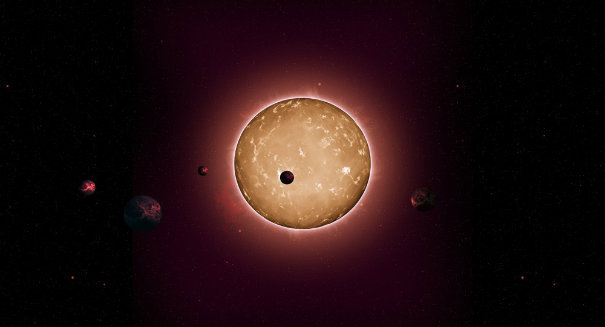
A "twin" of our own Solar system is nearly as old as the Universe itself
For the average observer, there is no topic in astronomy more interesting than the search for extraterrestrial life. While the jury’s still out on that front, astronomers analyzing data from NASA’s Kepler Spacecraft have discovered something amazing in the Milky Way that may have alien implications: An ancient “twin” of our own solar system that’s 11.2 billion years old, with five Earth-sized planets orbiting the star.
“This is one of the oldest systems in the galaxy,” said Steve Kawaler, an Iowa State University professor of physics and astronomy, noting that our sun is 4.5 billion years old. “Kepler-444 came from the first generation of stars. This system tells us that planets were forming around stars nearly 7 billion years before our own solar system.”
The star is noted as being 25% smaller than our own Sun, and located 117 light years away. The five observed planets range in size between Mercury and Venus. Unfortunately, it’s unlikely scientists will find any signs of life anytime soon – the planets are much hotter than Mercury, so close to Kepler-444 that they complete their orbits in less than 10 days.
Where the possible implications for alien life come in is the way Kepler was used to study the star. It read sound waves emitted from Kepler-444, which altered the star’s temperature. Those changes then created pulsating changes in brilliance that allowed scientists to determine its size. That’s the craft’s value – able to take such precise measurements of far away systems, astronomers can learn a lot about the history of the Milky Way galaxy.
“From the first rocky exoplanets to the discovery of an Earth-size planet orbiting another star in its habitable zone, we are now getting first glimpses of the variety of Galactic environments conducive to the formation of these small worlds,” the astronomers wrote in their new paper. “As a result, the path toward a more complete understanding of early planet formation in the Galaxy starts unfolding before us.”
The scope of planet formation being discovered suggests that any existing alien civilization could be far, far more ancient than our own. Though Kepler-444 is bright enough to be seen with binoculars here on Earth, that proximity shouldn’t be mistaken for insignificance. At 11.2 billion years old, it’s very nearly as old as the known universe itself.
“Kepler-444 is the oldest known system of terrestrial-size planets,” write the authors in the study. “We thus show that Earth-size planets have formed throughout most of the Universe’s 13.8-billion-year history, providing scope for the existence of ancient life in the Galaxy.”
Hello, after reading this amazing post i am too happy
to share my knowledge here with friends.
is a